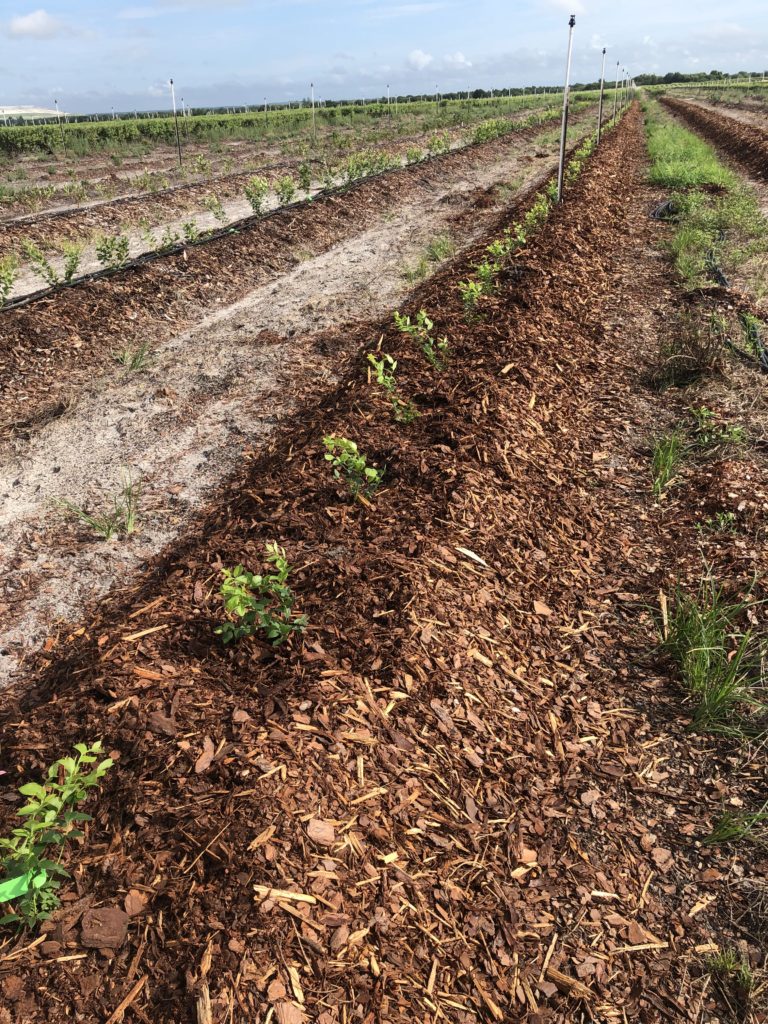By Doug Phillips and Jeffrey G. Williamson
Blueberries have specific nutrient requirements that differ from other horticultural crops. They have shallow root systems and no root hairs, which limits the ability to take up nutrients. Blueberries grow best in acidic soils (ideal pH range of 4.5 to 5.5) with at least 3% organic matter and prefer the ammonium form of nitrogen (such as ammonium sulfate and urea) to the nitrate form.

Florida blueberries are typically grown in milled pine bark beds (either 100% pine bark or incorporated into native soil) and require fertilization programs that differ from those for blueberries grown in native soil in other areas. This article will focus on fertilization of southern highbush blueberries in Florida planted in pine bark beds.
Although blueberries evolved under low-nutrient, acidic conditions, research has shown that fertilization is necessary for good plant growth and to maximize production in commercial settings. This includes both macronutrients (nitrogen, phosphorous and potassium) and micronutrients.
Nitrogen (N) is involved in plant growth and vigor, as well as floral bud initiation. Phosphorous (P) is important for root growth and energy transfer within the plant. Potassium (K) is involved in photosynthesis and water regulation. These macronutrients are typically applied as part of a complete N-P-K fertilizer. Micronutrients are applied either as part of a complete fertilizer or as a micronutrient supplemental package.
PROS AND CONS OF PINE BARK BEDS
Pine bark beds are used in Florida because the native soil is typically not acidic enough and has insufficient organic matter for good plant growth and fruit production. Pine bark helps to develop a more acidic rhizosphere and adds organic matter to the root zone. In addition, raised pine bark beds promote sufficient drainage and aeration, helping to minimize root diseases such as phytophthora.
However, the fact that pine bark does not retain water or nutrients very well requires consideration in developing a fertilization program. Also, new pine bark beds tend to tie up nitrogen, reducing the amount of nitrogen available for plant uptake until the bark begins to decompose.
FERTILIZATION RECOMMENDATIONS
For newly developed beds, it is suggested to condition the bark by applying nitrogen at least three months before planting.
It is typically better to make lighter, more frequent applications of fertilizer because pine barks beds drain very easily and nutrients can quickly be leached beneath the root zone, especially with heavy rainfall or irrigation. This can result in both insufficient nutrient uptake by the plants and leaching of nutrients into the groundwater. Another way of dealing with nutrient leaching is to use a slow-release or controlled-release fertilizer product, so that the release of nutrients into the root zone occurs more slowly.
Nutrients are typically applied by either broadcasting dry granular fertilizer or fertigating liquid fertilizer through a drip or Microjet irrigation system.
Granular fertilizers are available in regular, slow-release and controlled-release formulations. Although the slow-release and controlled-release formulations are higher in price, they generally last longer and help to minimize nutrient leaching. Granular fertilizers should be broadcast evenly above the root zone and not concentrated near the plant crown.
Fertigation allows for a greater degree of control over fertilizer placement, with smaller amounts applied more frequently, which reduces nutrient leaching. Foliar applications of fertilizer are sometimes done to supplement regular fertilization, but are not a substitute for regular granular fertilizer or fertigation.
NUTRIENT ANALYSIS
Nutrient analysis is an important part of the process of developing and adjusting a fertilization program.
Soil nutrient analysis should be performed before planting, especially if using beds of pine bark incorporated into native soil. This will determine the pH and amount of organic matter present. If pH is above the preferred range of 4.5 to 5.5, consideration should be given to lowering soil pH. This is frequently done through the pre-planting application of elemental sulfur. Pine bark will provide additional organic matter and contribute to soil acidification.
Leaf nutrient analysis should be performed at least once per year and is commonly done after harvest but before postharvest hedging.
Nutrients that are out of range (either deficient or excessive) should be considered when developing or adjusting the fertilizer program for the next year.
OTHER FACTORS TO CONSIDER
Fertilization programs can vary within Florida, for reasons including which cultivars are planted, age of plants, planting density, precipitation/irrigation amounts and whether a grower is using a deciduous (dormant) or evergreen production system.
Under the deciduous system, blueberry plants go dormant as fall progresses, and growers typically cut off fertilization during this dormant period. This is necessary to ensure that plants achieve dormancy (which helps protect them from winter freezes) and because the plants will not be taking up much in the way of nutrients during this time. Fertilization typically begins again with the emergence of vegetative bud break, although some growers reduce the amount of nitrogen just prior to and during harvest.
Under the evergreen system, plants do not go dormant, and some level of fertilization must continue during the fall and winter months to make sure the foliage remains healthy and intact to support an early harvest the following spring.
In summary, fertilization program decisions should be based on soil and leaf nutrient analysis, plant growth and stage of development, production system used, management practices employed, environmental conditions and grower experience with the crop and location.
MORE INFORMATION
See University of Florida Institute of Food and Agricultural Sciences (UF/IFAS) Electronic Data Information Source publications HS1356, Nutrition and Fertilization Practices for Southern Highbush Blueberry in Florida (edis.ifas.ufl.edu/pdf/HS/HS135600.pdf) and HS1197, How to Calculate Fertigation Injection Rates for Commercial Blueberry Production (edis.ifas.ufl.edu/pdf/HS/HS1197/HS1197-D77uf9fs3q.pdf) for more information on this topic.
Doug Phillips is a blueberry Extension coordinator at the UF/IFAS Gulf Coast Research and Education Center in Wimauma. Jeffrey G. Williamson is a UF/IFAS professor in Gainesville.









